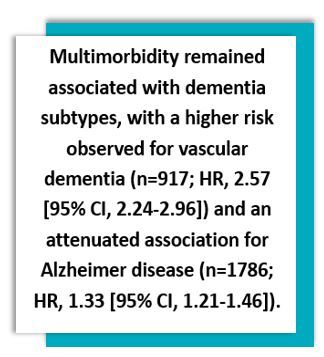- Clinical Technology
- Adult Immunization
- Hepatology
- Pediatric Immunization
- Screening
- Psychiatry
- Allergy
- Women's Health
- Cardiology
- Pediatrics
- Dermatology
- Endocrinology
- Pain Management
- Gastroenterology
- Infectious Disease
- Obesity Medicine
- Rheumatology
- Nephrology
- Neurology
- Pulmonology
Dementia Risk May be Driven by Multimorbidity vs Single Risk Factors, Suggests a New Study
Multimorbidity was associated with a 63% increased risk for dementia among adults older than age 60 years followed for up to 15 years.
©Billion Photos/Shutterstock

Multimorbidity was associated with a nearly two-thirds (63%) increased risk for incident dementia in a cohort of >200 000 older adults followed for 15 years, according to findings from a UK study conducted by researchers from the Nuffield Department of Population Health at the University of Oxford.
The investigators, led by Oxford's Catherin M Calvin, PhD, also found that elevated risk was associated with distinct clusters of disease and that the types of disease in those clusters differed between men and women. They suggest that their results could improve the ability to identify persons at high risk of dementia and could guide prevention efforts toward disease clusters rather than individual risk factors.
Calvin and colleagues point out that a number of cardiometabolic disease are already known to be potentially modifiable risk factors for dementia and that with age individuals are likely to develop more than 1 of the related conditions. The research question is whether multimorbidity might be associated with dementia and whether the risk may differ by distinct disease clusters and/or by genetic risk.
The 2 studies that have reported links between multimorbidity and dementia risk have been small, the investigators write, and may have lacked statistical power to detect associations with different clusters of disease and whether genetic risk might modify them.
Their population-based prospective cohort study drew data from the UK Biobank cohort from between 2006 and 2010. Participants included were aged ≥60 years at baseline and did not report dementia during nurse-led verbal interviews at baseline assessment centers.
The investigators suggest that their results could improve the ability to identify persons at high risk of dementia and could guide prevention efforts toward disease clusters rather than individual risk factors.
For purposes of the study multimorbidity was defined as presence of at least 2 long-term conditions from a preselected list of 42 conditions. High genetic risk for dementia was based on presence of 1 or 2 apolipoprotein (APOE) ε4 alleles.
Calvin and colleagues’ primary outcome of interest was incident dementia, with data derived from hospital inpatient and death registries. Cox proportional hazards models were used to assess associations of multimorbidity with dementia.
FINDINGS
The final cohort numbered 206 960. Mean age was 64 years and 52.7% were women. Multimorbidity was identified at baseline in 43.1%. During a mean follow-up period of 11.8 years, 3.0% of participants developed dementia.
The research team reports the incidence rate for dementia per 1000-person years for participants without multimorbidity was 1.87 (95% CI, 1.80 - 1.94) and for those with multimorbidity, 3.41 (95% CI, 3.30 - 3.53).
In models adjusted for age, sex, ethnicity, education, socioeconomic status, and APOE-ε4 carrier status, multimorbidity was associated with an increased risk of incident dementia (hazard ratio [HR], 1.63 [95% CI, 1.55-1.71]).
When the researchers compared risk of dementia among participants without multimorbidity to those with clusters of disease, they found the risk highest among women in clusters comprised of:

- Hypertension, diabetes, and coronary heart disease (HR, 2.20 [95% CI, 1.98-2.46]) and
- Pain, osteoporosis, and dyspepsia (HR, 2.00 [95% CI, 1.68-2.37])
In men, the highest risk for dementia was associated with disease clusters comprised of:
- Diabetes and hypertension (HR, 2.24 [95% CI, 1.97-2.55]) and
- Coronary heart disease, hypertension, and stroke (HR, 1.94 [95% CI, 1.71-2.20])
Calvin and colleagues’ analysis found no difference in APOE-ε4 carrier status by presence or absence of multimorbidity.
“The strongest associations with dementia for both sexes were identified for clusters largely driven by cardiometabolic and cardiovascular diseases, such as hypertension, diabetes, coronary heart disease, and stroke,” the authors write. Disease clusters may play a key role in stratification of risk for dementia and also help focus development of targeted interventions to prevent or delay the disease, they add.
Reference: Calvin CM, Conroy MC, Moore SF, et al. Association of multimorbidity, disease clusters, and modification by genetic risk factors with risk of dementia. JAMA Netw Open. 2022;5:E2232124. doi:10.1001/jamanetworkopen.2022.32124
